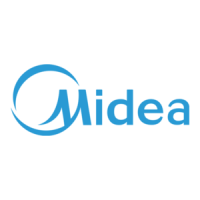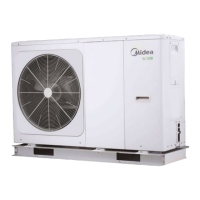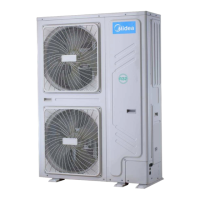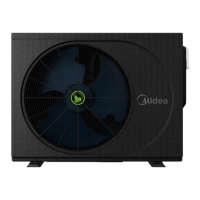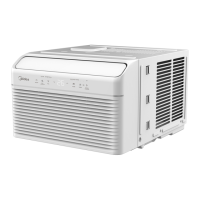Do you have a question about the Midea M-thermal Split MHA-V4W/D2N8 and is the answer not in the manual?
Explains DANGER, WARNING, CAUTION, NOTE symbols and general safety rules.
Covers electrical hazards, grounding, wiring, and circuit breaker requirements.
Lists included installation fittings like manuals and energy labels.
Instructions for confirming model/serial numbers and proper unit handling during installation.
Details on the fluorinated gas type (R32), GWP, and factory-charged volume.
Lists locations to avoid installing the unit due to environmental factors or potential hazards.
Guidance on installing the unit in cold regions to prevent wind exposure and snow impact.
Advice on positioning the unit to avoid direct sunlight affecting the thermistor and heat exchanger.
Provides detailed dimensions for 4/6kW and 8/10kW models.
Specifies requirements for the installation ground, foundation, and secure fastening with bolts.
Explains drain hole positions and the need for heating belts in cold weather.
Details required clearances for stacked and multi-row outdoor unit installations.
Outlines requirements for pipe differences, lengths, and bends in refrigerant piping.
Describes using soap water or detectors to check for leaks at various joints.
Specifies insulation material, thickness, and application for gas and liquid pipes.
Details pipe sizes for gas/liquid sides and connection methods like flaring.
Instructions for ensuring pipes are free of dirt and water before connecting.
Outlines the process for airtight testing using pressurized nitrogen.
Explains how to purge air from the system using a vacuum pump.
Provides a method to calculate the required additional refrigerant based on pipe length.
Safety guidelines for fixing cables, using ties, and terminal connections.
Advice on using appropriate terminals, wire gauges, and securing connections.
Guidance on selecting wire diameters and circuit breakers based on current ratings.
Details on removing the switch box cover and information on overcurrent protectors.
Steps for safely disassembling the outdoor unit.
Identifies the location of the electronic control box and how to access it.
Details the components and layout of the Inverter module PCB A.
Explains the components and connections of the Main Control Board PCB B.
Guidelines for performing test runs, including necessary pre-conditions and warnings.
Requirements for refrigerant charge limits in rooms and necessary ventilation measures.
Instructions for handing over the unit to the customer and explaining its operation.
Lists conditions under which the unit's protection equipment will activate.
Describes the unit's operation during and after a power outage.
Explains how heating capacity is affected by outdoor temperature and suggests auxiliary heaters.
Details the feature that prevents immediate compressor restarts after operation.
Explains that units in the same system cannot run cooling and heating simultaneously.
Describes how heating operation progresses and outdoor fan behavior.
Explains the automatic defrost process during heating and its effect on fan operation.
Lists error codes, their causes, and corrective actions for sensor and communication failures.
Provides key technical data like power supply, dimensions, weight, and refrigerant for different models.
Covers area checks, work procedures, general work area safety, and ignition source control.
Details checks for refrigeration equipment, including charge size, ventilation, and component resistance to corrosion.
Outlines initial safety checks for electrical components and repairs, including capacitor discharge and earth bonding.
Guidelines for working on sealed components, ensuring electrical disconnection and hazard warnings.
Procedures for repairing intrinsically safe components and checking cabling integrity.
Acceptable methods for detecting flammable refrigerants and leak detection techniques.
Steps for safely removing, evacuating, and charging refrigerant systems.
Best practices for handling refrigerant cylinders, earthing the system, and labeling.
Essential steps for safely decommissioning the unit and recovering refrigerant.
Guidelines for safe refrigerant recovery, cylinder use, and waste transfer.
Regulations and precautions for transporting, marking, and storing equipment containing refrigerants.
Diagram illustrating the refrigerant cycle with labeled components.
Detailed electrical wiring diagram for the 4~10kW outdoor units.
Explains DANGER, WARNING, CAUTION, NOTE symbols and general safety rules.
Covers electrical hazards, grounding, wiring, and circuit breaker requirements.
Lists included installation fittings like manuals and energy labels.
Instructions for confirming model/serial numbers and proper unit handling during installation.
Details on the fluorinated gas type (R32), GWP, and factory-charged volume.
Lists locations to avoid installing the unit due to environmental factors or potential hazards.
Guidance on installing the unit in cold regions to prevent wind exposure and snow impact.
Advice on positioning the unit to avoid direct sunlight affecting the thermistor and heat exchanger.
Provides detailed dimensions for 4/6kW and 8/10kW models.
Specifies requirements for the installation ground, foundation, and secure fastening with bolts.
Explains drain hole positions and the need for heating belts in cold weather.
Details required clearances for stacked and multi-row outdoor unit installations.
Outlines requirements for pipe differences, lengths, and bends in refrigerant piping.
Describes using soap water or detectors to check for leaks at various joints.
Specifies insulation material, thickness, and application for gas and liquid pipes.
Details pipe sizes for gas/liquid sides and connection methods like flaring.
Instructions for ensuring pipes are free of dirt and water before connecting.
Outlines the process for airtight testing using pressurized nitrogen.
Explains how to purge air from the system using a vacuum pump.
Provides a method to calculate the required additional refrigerant based on pipe length.
Safety guidelines for fixing cables, using ties, and terminal connections.
Advice on using appropriate terminals, wire gauges, and securing connections.
Guidance on selecting wire diameters and circuit breakers based on current ratings.
Details on removing the switch box cover and information on overcurrent protectors.
Steps for safely disassembling the outdoor unit.
Identifies the location of the electronic control box and how to access it.
Details the components and layout of the Inverter module PCB A.
Explains the components and connections of the Main Control Board PCB B.
Guidelines for performing test runs, including necessary pre-conditions and warnings.
Requirements for refrigerant charge limits in rooms and necessary ventilation measures.
Instructions for handing over the unit to the customer and explaining its operation.
Lists conditions under which the unit's protection equipment will activate.
Describes the unit's operation during and after a power outage.
Explains how heating capacity is affected by outdoor temperature and suggests auxiliary heaters.
Details the feature that prevents immediate compressor restarts after operation.
Explains that units in the same system cannot run cooling and heating simultaneously.
Describes how heating operation progresses and outdoor fan behavior.
Explains the automatic defrost process during heating and its effect on fan operation.
Lists error codes, their causes, and corrective actions for sensor and communication failures.
Provides key technical data like power supply, dimensions, weight, and refrigerant for different models.
Covers area checks, work procedures, general work area safety, and ignition source control.
Details checks for refrigeration equipment, including charge size, ventilation, and component resistance to corrosion.
Outlines initial safety checks for electrical components and repairs, including capacitor discharge and earth bonding.
Guidelines for working on sealed components, ensuring electrical disconnection and hazard warnings.
Procedures for repairing intrinsically safe components and checking cabling integrity.
Acceptable methods for detecting flammable refrigerants and leak detection techniques.
Steps for safely removing, evacuating, and charging refrigerant systems.
Best practices for handling refrigerant cylinders, earthing the system, and labeling.
Essential steps for safely decommissioning the unit and recovering refrigerant.
Guidelines for safe refrigerant recovery, cylinder use, and waste transfer.
Regulations and precautions for transporting, marking, and storing equipment containing refrigerants.
Diagram illustrating the refrigerant cycle with labeled components.
Detailed electrical wiring diagram for the 4~10kW outdoor units.
